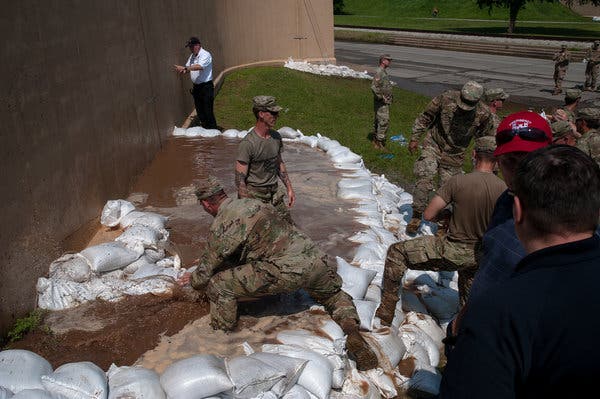Advertisement
Hospital ships stayed in port, veterans hospitals awaited orders and requests for help went unanswered, as much of the government remained on the sidelines.

WASHINGTON — The mayor of Seattle wanted “mass tents” from the federal government to rapidly build shelters to house people in quarantine. The state of New York pleaded for help from the Army Corps of Engineers to quickly build hospitals. Oregon’s governor repeatedly pressed the Department of Health and Human Services for hundreds of thousands of respirators, gowns and gloves, face shields or goggles.
After so many pleas, President Trump moved on Tuesday to begin enlisting much of his government in what the White House had called for weeks a “whole of government” approach to the rampaging coronavirus.
“We are starting the process,” Mr. Trump said during a news conference Tuesday afternoon, referring to New York’s request to enlist the Army Corps of Engineers. “The state is working on it very hard themselves, but we’ll probably supplement what they’re doing.”
The shift came four days after an internal report from the Department of Health and Human Services — not yet shared with the public — concluded that the “pandemic will last 18 months or longer and could include multiple waves of illness.”
The virus, the agency assumed, will likely cause “significant shortages for government, private sector, and individual U.S. consumers,” and coordination by the federal government would be imperative, according to the document.
Yet despite promises of a “whole of government” effort, key agencies — like the Army Corps of Engineers, other parts of the Defense Department, the Federal Emergency Management Agency and the Department of Veterans Affairs — had not been asked to play much of a role.
Even after Mr. Trump committed to supporting the states on Tuesday, the Army Corps of Engineers said it still had not received direction from the administration.
“We need the federal government to play its role,” Gov. Andrew M. Cuomo of New York said Monday. “The federal government has tremendous capacity.”
Much of that capacity is untapped. Hospital ships are at port. The Department of Veterans Affairs, legally designated as the backup health care system in national emergencies, awaits requests for help. The veterans department has a surplus of beds in many of its 172 hospital centers and a robust number of special rooms for patients with breathing disorders.
The sprawling system of emergency doctors and nurses ready to be deployed by the Department of Health and Human Services — known as the National Disaster Medical System — is also still waiting for orders, other than to staff locations where passengers offloaded from cruise ships are being quarantined.
And the Defense Department, home to 1.3 million active-duty troops and a civilian and military infrastructure that has made planning for national emergencies almost an art form, has yet to be deployed to its fullest capabilities. Senior Pentagon officials say they are ready to assist in any way that is ordered, but they also caution that much of the military’s emergency medical care is designed for combat trauma or natural disasters, and not mass quarantine for infections.
The last time a big infectious disease epidemic emerged, President Barack Obama dispatched nearly 3,000 American troops to Liberia to build hospitals and treatment centers to help fight Ebola. The Pentagon opened a joint command operation at a hotel in Liberia’s capital, Monrovia, to coordinate the international effort to combat the disease, and the American military provided engineers to help construct additional treatment facilities and sent people to train health care workers in West Africa to deal with the crisis.
The Pentagon has been running through plans for how the American military can help: from deploying the Navy hospital ships Comfort and Mercy to the Hudson River in New York or off the West Coast, to building tent cities near urban hospitals to triage cases.
Defense Secretary Mark T. Esper said on Tuesday that the Pentagon will make available to the Department of Health and Human Services up to 5 million N95 masks, which can be used to help protect health workers and vulnerable people against the virus. The first 1 million, he said, would be available immediately.
The Pentagon is also making available 2,000 ventilators for hospitals, a number that would likely fall far short of the expected need. “When you look at how many people who may need it, 2,000 doesn’t put much of a dent into it,” Mr. Esper said.
While the military has infrastructure to help, there are limits. Field hospitals and the hospital ships Comfort and Mercy are designed for trauma wounds, not viruses, and doctors would have to be assigned from elsewhere to staff them. The ships, each with a 1,000-bed capacity, have helped in natural disasters like tsunamis, hurricanes and earthquakes, not quarantines.
Defense Department officials said that one possibility for the Comfort would be to station in New York Harbor and absorb non-coronavirus patients in New York, which could free up hospital beds in Manhattan to attend to infectious cases.
Gov. Jay Inslee of Washington said he spoke with Mr. Esper on Tuesday about getting access to resources that could help bolster new medical hospitals. “I would predict that we’re going to be getting real help from the Department of Defense,” Mr. Inslee said.
Part of the challenge is the unusual role Mr. Trump has assigned to FEMA, which traditionally is designated as the lead federal agency during major disasters to take requests from individual states and then assign other federal players to deliver on the pleas for help. In this case, Mr. Trump has left the Department of Health and Human Services in charge.
“FEMA is the only agency that has the full breadth of the federal government at its disposal,” said Daniel J. Kaniewski, who in January left FEMA, after serving since the start of the Trump administration as one of the agency’s top officials.
The disaster is so far-reaching, the federal government would never be able to address all of the requests for help, said W. Craig Fugate, who led FEMA during the Obama administration.
“Most disaster supplies are set up for localized disaster response,” he said, “not something that is occurring across the nation all at the same time.”
Oregon sent a letter to Vice President Mike Pence on March 3 asking for 400,000 N95 masks. For days, it got no response, and only by March 14 received its first shipment, of 36,800 masks. But there was a problem. Most of the equipment they got was well past the expiration date and so “wouldn’t be suitable for surgical settings,” the state said.
New York City also put in a request for more than 2 million masks and only received 76,000; all were expired, said Deanne Criswell, New York City’s emergency management commissioner. The city is also requesting additional beds for intensive care units and medical teams to staff a convention center that may be turned into a temporary medical facility.
“It’s been extremely inadequate,” Gov. Kate Brown of Oregon told reporters late last week of the response from the federal government, which offered to send the state only a fraction of the medical supplies she had requested. “We’ve been contacting this administration every single day since then and we have received nothing. Zip. Zero. Nothing from them.”
Mr. Cuomo expressed appreciation for the rapidly growing capacity to conduct coronavirus tests, which has been the delay that so far has drawn the most attention. But the real need now is for a much broader response, he said. His wants the Army Corps of Engineers to help New York set up temporary hospitals — as he said he fears the state is about to face a disastrous shortage of hospital beds, particularly in intensive care units.
“They build airports,” he said. “They build the bridges. They build hospitals. This is exactly what they do.”
A spokeswoman at the Army Corps of Engineers said on Tuesday that the agency — which has had its massive capacity put to use in past disasters like Hurricane Katrina — was still awaiting orders.
“The U.S. Army Corps of Engineers is prepared to assist the nation in a time of crisis to the very best of its capabilities, and we are postured to lean forward when an official request is received through the Department of Defense,” Raini W. Brunson, an Army Corps spokeswoman said in a statement. “However, at this time, we have not been assigned a mission.”
Mr. Trump on Tuesday said he had recently spoken with Mr. Cuomo and that discussions had begun with Defense Department officials about possibly building pop-up hospitals, with sites even under consideration. He also suggested that FEMA will soon be playing a more aggressive role.
“We are working closely and getting FEMA involved,” Mr. Trump said.” They have been involved but we are getting them involved to a different level.”
But other agencies remain quiet. Veterans groups say the Department of Veterans Affairs has not appeared front and center of any of the emergency response communication efforts.
“The nation has not embraced the scope of the V.A.” said Randy Reese, the executive director of the Washington headquarters of Disabled American Veterans. “They need to send the message that we are prepared and right now we have not seen or heard that and it brings some sense of concern.”
FEMA officials said the Department of Health and Human Services remains in charge of the federal response, and it too is waiting for orders from the agency before it moves to ramp up assistance.
“FEMA will continue supporting all states and territories during this dynamic situation,” Lizzie Litzow, a FEMA spokeswoman, said.
The Department of Health and Human Services did not respond to requests for comment.
In previous national emergencies, FEMA would be responsible for finding out where to obtain masks, ventilators, hospital beds and tents from either the military or the private sector and ensuring the supplies are delivered to states, according to Michael Chertoff, the secretary of homeland security under President George W. Bush who oversaw the response to Hurricane Katrina.
“They have relationships and know where to look for things,’ Mr. Chertoff said. “Without that it’s not clear to me who would be doing the coordination and facilitation function.”
Eileen Sullivan and Jennifer Steinhauer contributed reporting.


